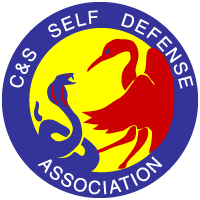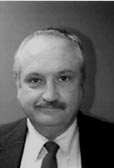
|
C&S Online
An Online Newsletter For The
C&S Self Defense Association
Fall 2001
Confidence. Fitness. Success.
|
|
Thoughts From The Board of Directors...
|

|

|
Alive & Kicking
Grandmaster Paul B. Dusenbery
|
|
The Quantum Leap
What do you think the relationship is
between a hydrogen atom and our Art? One of my new students in the Commerce dojo, John, and I were discussing the concept of "quantum leap" as it pertained to karate teaching and learning. John, by the way is a second degree black belt in Ninjitsu, who started studying with me several months ago. I was saying that learning often takes place very rapidly and unpredictably. That a real measurable understanding can take place in a "quantum leap". John thought that this phrase meant that learning must be a small step because a quantum is such a small thing. Do you know what a quantum is? How about a quantum leap?
One of the great discoveries of the previous century was the idea that atoms possess very discrete energy levels that energy on the atomic scale comes only in very small units called a quantum. When an excited atom wants to release some energy it can only do so by emitting a light particle called a photon that possesses a very specific amount of this atomic energy. Quantum Mechanics is able to explain the amazing interaction between light and matter. A quantum leap refers to this incredible change in the state of an atom when one or more of its electrons move from one quantum level to another. It's a transition that is all or nothing there is no in-between allowed. It is this almost magical transition that takes place in the atom that is a great metaphor for how we learn not only our Art but also how we learn anything. Another great concept from the world of the atom is Heisenberg's "uncertainty principle" that has played an important role in modern philosophy. I may discuss the meaning of this principle in a future article.
Learning is not continuous. Children and adults do not learn at a fixed rate that grows over time. In fact learning is quite different. It is very unpredictable. Systems experts would call it nonlinear. Have you ever explained something to someone who you thought "got it" but in fact had erroneous ideas and misconceptions about what you were teaching? This happens all the time. You may have been taught a front kick, for example. How many times was it shown and described before you were able to actually perform the technique correctly? It could be many times. In fact, when you were able to integrate your knowledge of how to do the kick properly, it probably took you a very short while to put this knowledge to use in performing a good kick. The moment when a student is able to perform and understand what he or she has been taught is often referred to as an "ah ha" event. If this happens suddenly, the student is said to have made a "quantum leap" in their understanding.
The teacher's role in this process is very important. He or she must cultivate a positive learning environment that allows students the opportunity to progress at their own nonlinear rate. When it is time for a student to make the leap, the teacher must be there ready to help facilitate the experience. It won't do to say at the beginning of class that so-andso will be making a "quantum leap" today. It would of course be convenient to schedule one's leaps in this fashion but unfortunately Nature doesn't work quite like that. No, a good teacher will be aware that a student is getting ready for the leap and will be able to modify their approach to better take advantage of this precious moment. Because learning is nonlinear so must teaching be. My students will understand when I say that I especially like the nonlinear teaching method of students doing push-ups. I always say that it makes the mind and body strong. My students also know that it hurts me more than them to have to give push-ups. While I'm trying to be a bit funny, the point here is that we all need to develop a variety of teaching methods that can be used to foster the "I finally got it" moment.
Because so many of us are asked to teach others in so many different ways, it is good for each of us to reflect on this important teaching/learning duality. Remember some of the keys to good teaching: knowledge, passion, motivation, engagement, perspective, and awareness. The latter key is required to help your students' master their own personal "quantum leaps" on their road to understanding.
Grandmaster Paul B. Dusenbery, PhD holds a 7th Degree Black belt. He began his studies with Grandmaster Rose in 1972. Dr. Dusenbery is a space scientist, writer, lecturer, and is the Executive Director of the Space Science Institute in Boulder, CO. He oversees the Dusenbery Tiger leg of C&S. Grandmaster Dusenbery can be reached at dusenbery@spacescience.org.
Top | Front Page | Board | Featured | Happenings | Views | Back Page | C&S Home
|

|

|
The Dragon's Tail
Senior Master David R. Landers
|
|
What's Really Practical?
I hope that I don't repeat myself
too often in my newsletter offerings, but a.) I am getting old and tend to forget that I might be rambling, and b.) I am getting old and tend to forget that I might be rambling. Seriously, my slant on this thing that we do is always driven by whatís practical and what is going to keep us alive on the street. After World War I, the Army evaluated marksmanship and individual soldierís performance, with an eye toward revising their training methods. It was noted that marksmanship was poor, when shots fired to achieve enemy casualties was calculated. Even more disappointing was the fact that many soldiers didnít fire at all. To make a long story a little shorter, it was theorized that the bullís eye targets that the soldiers trained on were so dissimilar to what a soldier was supposed to shoot at (another soldier) that the training was of little use in the field. Coupled with a normal humanís aversion to harming another person, this lack of practical target shooting experience was a large factor in the general poor performance in the field. So a humanistic silhouette target was introduced and the problem in the next war was greatly diminished. In fact the same target is still in general use. Police officers use an even more realistic target, and special operations units of both the police and the military use photo-realistic target images. The bottom line is ďWe react the way we were trainedĒ. That does not mean that if we shoot at a realistic target once, or even once in a while, and our inhibitions disappear. It means that if we train hard enough and consistently enough, in a realistic manner, we can have a reasonable expectation of the kind of carry-over that results in our survival.
Recently in a combined Illinois/Texas workout, we examined the aspect of reality training. How do we, as human beings, react to danger, stress, and threat? The truth is that we WILL react as we are programmed by nature to react. And that is we will:
- Square our bodies to a threat.
- Focus on any weapon that we feel threatened by.
- Grab at anything that is propelled in our direction.
Now I know that we spend hours on X-blocks and other foils to knife attack. I, for one, recommend attacking the knife wielder. But if the knife is swung, or thrust, at us in an unsuspecting moment, we WILL grab at it. And if we donít realize that, and take it into account in our training, we are not being realistic. And we are not being safe. We spent some time, in our workout, exploring what we would do if we found ourselves grabbing a knife blade. Itís not the end of the world and it can work for you, although it certainly isnít my idea of an ideal defense. The point is that it is a likely result and not to train for it is not good planning.
I have mentioned many times before, as has Grand Master Rose, that we have an enormous wall to break through against striking another person, even if that person richly deserves it. That wall can be breached by training and by practice, but lets make that practice as realistic as we can. I never endorse products, probably because they refuse to pay me for them, but I do like two training aids that we use in some of our Illinois schools. The first is the Century Muay Tai heavy bag. The reason we like it is that it extends almost to the floor, giving it a low center of gravity which reduces swing, which makes its action more realistic and makes it great for shin strikes and for the smaller karateka in the Dojo. The second device is the striking dummy that looks like a human torso and head; we call ours ďBobĒ. It, like the human silhouette target, is a great way to bridge the gab between training and reality. We like to dress ours up with tee shirts and other odds and ends to increase the realism. This item is, I think, also from Century. I, again, donít endorse anyoneís products but I am very pleased by their customer service people telling us that we are the only ones who tear up their water filled kicking targets. My response is that we are the only ones who know how to kick (thank you Grand Master) and that if they want, we will do their product testing for them.
Remember; train like you expect to react. Make training realistic. Get used to hitting hard. Punching air is only useful for getting your form right. Power comes from hitting something. The first time I tried to use an elbow in a fight I hit air, I reevaluated, adjusted my aim and hit air again! If you want to hit something with your elbow, visualize striking about an inch or two above your wrist. That should be just about right. Or so the guy would have said the third time I tried.
Master David R. Landers holds a 6th Degree Black belt. He began his studies with Grandmaster Rose in 1969. He served as Deputy Chief of Police of Effingham, Illinois from 1997 to 2000 when he assumed the role of Illinois State Field Coordinator for the Midstates Organized Crime Information Center. He oversees the Landers Dragon leg of C&S. Master Landers can be reached at landers@effingham.net.
Top | Front Page | Board | Featured | Happenings | Views | Back Page | C&S Home
|
Website design by Peter Rose, zzrose@yahoo.com
|


